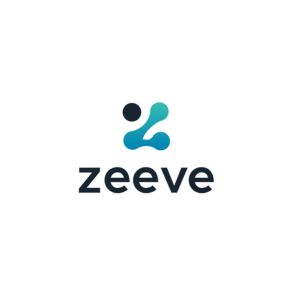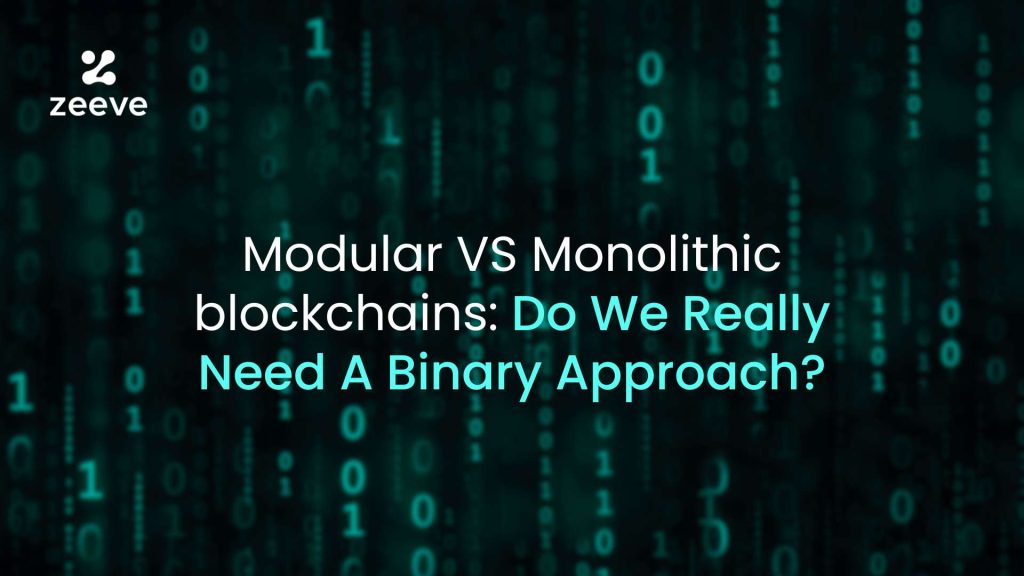Modular Vs. Monolithic Blockchain: Do We Really Need A Binary Approach?
 Zeeve
Zeeve
In the world of blockchains, success shouldn’t be defined in black and white, but a gray area exists, nonetheless. How? For perspective, when I logged into Twitter and inputted two words, (i) Monolithic and (ii) Modular, I saw a biased view all around. The septuagenarian army of degens of the erstwhile blockchain space, those from the 2008 era, find monolithic chains relevant, while, at the other end of the spectrum, we have the GenZ blockchain audience idolizing modularity and flexibility. But is such categorization of modular and monolithic blockchains in the equation of binary appropriate?
Rather than saying Solana, Ethereum, Aptos Vs. Optimism, Arbitrium, Cosmos: Wouldn't it be better to say Ethereum, Aptos, and Solana with Arbitrium, Cosmos, and Optimism after acknowledging some of their key trade-offs? I weigh in favor of the latter. How’d I prove that? Let’s look at the Quantum Thesis, which says dependency shouldn’t be binary like 0 or 1 but quantum, existing in both states.
The Modular Vs the Monolithic: Is it Really a War?
When we resonate with the monolithic chains, they have vertical integration of all the segments, like the Execution Layer, Settlement Layer, Data Availability Layer, and Consensus Layer nested on the top of a single framework.
In contrast, a modular approach disintegrates into separate layers of Execution, Settlement, Data Availability, and Sequencing. So, you get that flexibility and higher scalability. But is that all you want?

The Composability Is the Missing Piece
While developing on top of a modular blockchain, you have to set up separate stacks to perform different functions. For example, you might use the Celestia blockchain for the DA layer, a roll-up environment for sequencing, and other L1 chains like Ethereum for Settlement and Consensus.
For someone, who is not very well versed with the blockchain infrastructure, they will have to manage and maintain those different technology architectures to support the respective functions. Such a process is extremely extraneous and time taking. At the same time, it is extremely expensive. It deploys everything on the same layer when comparing the same with a monolithic stack. So, it is ideally suited for those applications that do not need their own expensive architecture. On the contrary, they can run on a public network and function. So, if such applications want to develop on top of the blockchain, where would they go? On a positive note, they would go for the monolithic blockchains because they have an easy-to-compose decentralized ecosystem that can function with other blockchain primitive layers. But what about the flexibility?
The Flexibility is the Missing Piece
The parity is not complete until a drawback of one is the edge of the other. Modular blockchains have a clear upper hand when you want to extract a lot of value from your application. For example, you want your own token to have a network effect. Or you want to enjoy compliance and permission and risk not losing flexibility. In this respect, where would you head? You would always prefer modular blockchains because there’s always room for diversification. You can diversify your revenue angle and include that within your ecosystem. Is it possible with monolithic blockchains? No.
Because, on monolithic blockchains, you need the permission of the network, and if they do not allow it, the chain shall fork, as we have already seen with The Shapella Fork during Ethereum, where stakers were given a chance to withdraw their ETH. So, you get more flexibility while operating on top of a modular chain where you can predefine your own rules and functions that don’t slow down your operations. On top of that, have the discretion to define your own block space and include more transactions as per the need of the project. Why is it necessary? We have already seen what monolithic blockchains can unleash during the Merge event when the quick network impact followed at the time people rushed to withdraw their ETH. So, if you have such a situation where, over a period of time, you should be given the flexibility of wrapping up your projects and withdrawing, or you want to enjoy true sovereignty with regard to introducing new features into your application or increasing the transaction speed, for such requirements. Ideally, a modular blockchain will make more sense than a monolithic blockchain. Why? Because, at times, we have seen that the supporting layer often outsmarts the application itself. To help check that, modularity gives you an edge. For example, FriendTech was able to capitalize more in revenue share in comparison to Base because it was FriendTech that supercharged the Base Network. So, if you have to seek possibilities where your app needs more control independent of the blockchain, the modular way makes more sense.
How do we turn decisive if monolithic blockchains win the composability games and modular the flexibility dilemma. That’s where we find the missing piece;
The Quantum Thesis?
The quantum thesis says, “You should have the power to co-exist within both the ecosystem for sustenance.” To put that into perspective, you must have a hybrid approach to looking at things while developing your own applications on top of the blockchains. If the use cases are designed so that they can function on general-purpose requirements. In that regard, you can enjoy the monolithic interaction because chains can easily communicate with each other. This could significantly supercharge the liquidity and make operations oversimplified.
However, suppose you have a requirement where you need an evolutionary ecosystem, guaranteed uptime or you want a predefined revenue model independent of the mainchain used for consensus and settlement. In such a case, you are comfortable building on top of a semi-walled ecosystem supporting nearby similar use cases. In that case, you can always have a modular approach to building the technology stack because you can break free and make super significant changes, which are difficult while operating in a monolithic stack.
Where Would You Go?
It entirely depends on how you would like to see your project performing. For example, after the Bitcoin and Ethereum forking as separate chains, the resultant product, Bitcoin Cash and Ethereum Classic, failed to catch up with their parent chains regarding community, network effect, and user base. So, if you have a concern that in the near future, I might have to look for such changes, in that case, a modular stack might make more sense to you to avert what happened to the above forked chains. .
Whereas, if you think that you have to create a standalone value effect for your application over a longer period of time, in that case, you can always pick a modular stack because applications like Uniswap, Lido, MakerDAO as separate chains have amassed network fees which have dwarfed even the earnings of their base chains. But they did create points of failure in doing so because when you exercise more control over your own ecosystem, the trust fades because Lido controls more ETH than Ethereum itself, which sometimes creates insecurity in the minds of the investors. So, as investors, you have to make your own choices.
You need maximum modularity, maximum security, or both. I leave it up to you to decide which blockchains will make more sense in the near future. However, undoubtedly, we cannot ignore the fact that the Quantum thesis will still be relevant because we need some parts of the security and composability that monolithic grants, and at the same time, we cannot fully ignore the fact that the world is changing. Applications must be adaptive to the change and not be sabotaged by older technologies obstructing adaptability for the good.
In that respect, using a modular blockchain makes more sense because we might see blockchains evolving over the period where general-purpose computation might move to other chains and networks to scale the ecosystem without compromising decentralization and security. Modular blockchains have already introduced DAS concepts that have significantly reduced data storage. So, they could scale to 1000s of transactions instead of 100s using the DAS to validate data availability.
Zeeve is your preferred platform for modular and monolithic blockchains
Whether you want monolithic/integrated blockchains or a complete modular stack for building your own chain from scratch, Zeeve provides access to both. Users can utilize Zeeve’s Rollups-as-a-service(RaaS) and appchain infrastructure to build modular blockchains with smart contract rollups, sovereign rollups, and standalone blockchains using Cosmos SDK and Substrate framework. You can build Optimistic rollups using OP Stack, Arbitrum Orbit, and ZK rollups with Polygon CDK and zkStack. With our integration partners, Zeeve also provides you the option to choose separate DA layers, sequencers, interoperability layers, etc, as per your requirements. Plus, you can get full and validator nodes for all the top integrated blockchains like Ethereum, Solana, Cardano, Aptos, Sui, etc, with automated no-code deployment on the Zeeve platform.
To get started with your journey into the layers of blockchain, be it modular or integrated, contact our Zeeve experts, and we may help you choose the right solution for your application.
Subscribe to my newsletter
Read articles from Zeeve directly inside your inbox. Subscribe to the newsletter, and don't miss out.
Written by

Zeeve
Zeeve
Zeeve is an enterprise-grade low-code Blockchain Infrastructure-as-a-Service platform, compliant with ISO 27001, SOC2 Type II, and GDPR standards. We are the leading provider of Rollups-as-a-Service, dedicated node infrastructure, and hosted subgraphs. All the infrastructure managed by Zeeve includes 24x7 monitoring, Enterprise SLA, 99.9% uptime guarantee, and management dashboards to ensure a secure and scalable infrastructure. With support for all major Blockchains, 27,000+ platform users, and 40+ enterprise clients, Zeeve stands tall as the global go-to provider for Web3 infrastructure.
